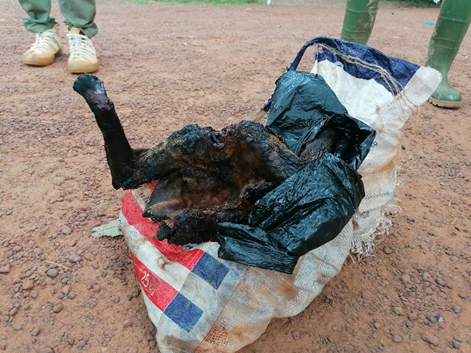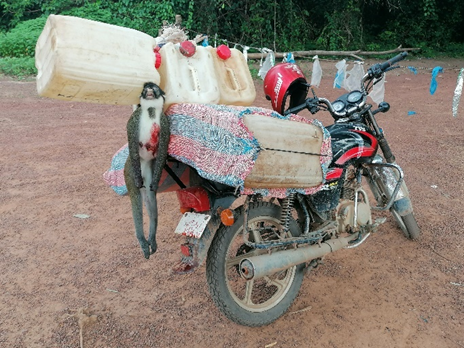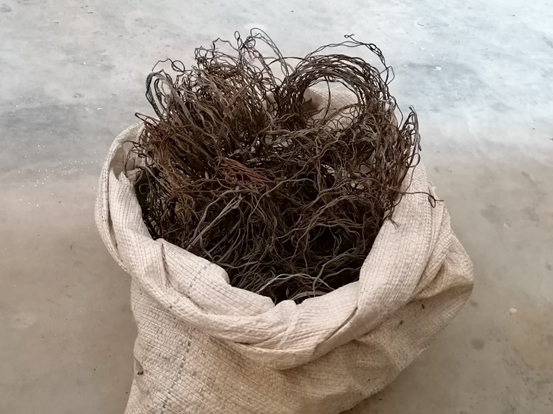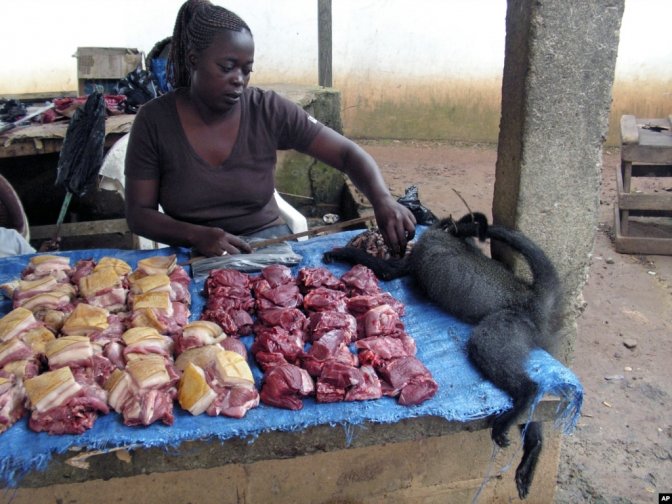Home / Guinean forests / Threats / Poaching and the illegal wildlife trade
Poaching and the illegal wildlife trade
There is growing evidence that many forests, even if the tree cover is relatively well preserved, are essentially devoid of wildlife, a phenomenon sometimes referred to as the ‘silent forest syndrome’.
The disappearance of many animal species and/or the abundance of surviving species is a serious threat to these forests, as animals all have an ecological role to play. In addition, they have an economic role, for example by providing protein or enabling tourism.

There are agreed to be two major causes for this scourge, which is sometimes referred to as ‘defaunation’: overharvesting for meat consumption; and illegal trade to fuel the resale of live species or animal parts (ivory, skin, scales etc.).
Poaching and unsustainable hunting
Poaching refers to the illegal hunting of a species, either because it is protected throughout the territory or because it is in a National Park or other Protected Area that prohibits hunting.
Unsustainable hunting refers to village hunting for meat consumption, which may be permitted by law, but for which the volume is too large to ensure that it is sustainable over time.
Although the context is somewhat different, studies on bushmeat consumption in Central Africa show that about four to five million tons of meat is consumed each year; this is an important economic sector and is worth, for example, nearly 100 million euros per year in Cameroon alone.
All studies indicate that consumption is too high to be sustainable; in one area of southern Cameroon, for example, village consumption is more than 30 kilos per km2 per year and hunters all confirm a continuous decrease in the species hunted.

Different measures can be taken to combat illegal and/or unsustainable hunting. For protected species, anti-poaching measures can be used to limit the harvest. For unsustainable hunting, projects to support village communities can provide alternatives to hunting as a means of subsistence, and other measures can provide alternatives to wild animal protein, for example through the promotion of small-scale farming.
Illegal trade
Some species, such as elephants and pangolins, have been trafficked for the international trade to such an extent that they have disappeared from many areas. Pangolins, described as the world’s most trafficked animal, have been the subject of increasing illegal trade in the region. The collapse of Asian pangolin populations, together with the high value of pangolin products, has led criminals to source pangolins from Africa. While the true impact of the illegal trade in this species in West Africa is largely unknown, the scale of trafficking (e.g. over 20 000 kg of African pangolin scales were seized between 2012 and 2016) is a major concern.

An analysis revealed that, of the world’s 50 largest seizures of ivory where the origin was identified, 21% came out of West or Central Africa. West Africa is not only a source of illegal ivory, it has also become a transit centre, with ivory being imported and exported from other parts of Africa.
The Economic Community of West African States (ECOWAS) and its 15 member states are committed to preventing any further degradation of West Africa’s biodiversity as a result of this crime. Coordination in the fight against wildlife crime in West Africa has been put in place through a Strategy for Combating Wildlife Crime in West Africa. This strategy focuses on interventions at three levels in the trafficking chain: stemming the supply (anti-poaching), breaking the links in the transit chain (roadside checks, checks at ports and airports, intelligence about networks, etc.) and, finally, reducing demand (raising awareness among potential consumers).

Finally, wildlife crime should not be seen solely as a conservation issue, as the impacts are far greater than the loss of individual species. It has a direct and negative impact on the economy and security of millions of people. The United Nations Environment Assembly recognises that the illegal trade in wildlife species ‘contributes to damage to ecosystems and rural livelihoods, undermines good governance and the rule of law and threatens national security and has a negative impact on sustainable utilization, including ecotourism and wildlife-based tourism’. (https://wedocs.unep.org/bitstream/handle/20.500.11822/34318/UNEA1R.pdf?sequence=1&isAllowed=y).


